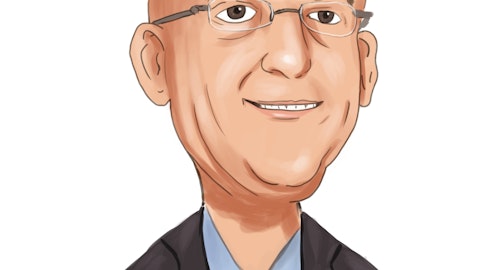S&T Bancorp, Inc. (NASDAQ:STBA) Q3 2023 Earnings Call Transcript October 19, 2023
S&T Bancorp, Inc. misses on earnings expectations. Reported EPS is $0.87 EPS, expectations were $0.9.
Operator: Welcome to the S&T Bancorp Third Quarter 2023 Conference Call. After management’s remarks, there will be a question-and-answer session. Now, I’d like to turn the call over to the Chief Financial Officer, Mark Kochvar. Please go ahead.
Mark Kochvar: Great. Thank you. Good afternoon, everyone. Thank you for participating in today’s earnings call. Before beginning the presentation, I want to take time to refer you to our statement about forward-looking statements and risk factors. This statement provides the cautionary language required by the Securities and Exchange Commission for forward-looking statements that may be included in this presentation. A copy of the third quarter 2023 earnings release as well as this earnings supplement slide deck can be obtained by clicking on the materials button in the lower right section of your screen. This will open up a panel on the right where you can download these items. You can also obtain a copy of these materials by visiting our Investor Relations website at stbancorp.com. With me today are Chris McComish, S&T’s CEO; and Dave Antolik, S&T’s President. I’d now like to turn the call over to Chris.
Chris McComish: Mark, thank you. And good afternoon, everybody, and welcome to our call. I certainly appreciate all the analysts being here with us this afternoon. We look forward to your questions. I also want to thank our shareholders and employees listening in on the call. It’s our employee commitment and engagement that drives these results, and we’re all proud to share them with you. Before I get into the numbers, I want to further emphasize how good I feel about the progress we’re making to move S&T forward around what we have defined as our people forward purpose. This purpose is guided by our values that shape who we are as a company and is propelled by our key performance drivers, one, growth in health of our deposit franchise; two, solid credit quality; three, best in class core profitability; and four, all of this is underpinned by our focus on enhancing employee engagement and talent.
This work translates in delivering for both, our customers in the communities that we serve in a differentiated way, and it’s further evidenced by the efforts of all of our team and in the results that we’ll discuss today. You’ll see on the page highlighted that, for the quarter, third quarter, we delivered $0.87 a share, or just over $33 million in net income. That’s driven by our fourth straight quarter of net interest income in the high-$80 million range. We’re very happy with our continued top quartile net interest margin at 4.09%, though it did decline quarter-to-quarter. Our PPNR again is top quartile at just under 2% at 1.99%, and our return metrics are also very strong. And that combined with our capital levels certainly position as well for the future.
Net charge-offs were 20 basis points in the quarter and our efficiency ratio remained well within our range at 52.68%, little bit up over Q2. We’ll talk further about that, but still where we expected it to be. Moving forward, before I turn it over to Dave to talk about our — the loan side of our balance sheet, you can see the deposit mix basically stabilized for the quarter. We showed about flat customer deposits with mix shifting a little bit from our DDA balances and savings into CDs and $80 million of customer CD growth was split between about $30 million of deposits new to the company and $50 million of shifts within the balance sheet. We continue to proactively work hard on customer relationships, expanding those deposit opportunities, protecting what we have while balancing growth and margin and cost and focusing, as I said, on our relationships.
I’ll turn it over to Dave to talk about the loan side of our balance sheet, and look forward to your questions in a little bit.
Dave Antolik: Well, thank you Chris. And continuing this review of our balance sheet, we did see increased loan growth in Q3 of $196 million or almost 11% annualized. This growth was driven by increases in both our residential mortgage and commercial real estate categories. Regarding our residential mortgage activities, we continue to see solid demand for construction and purchase related products and anticipate this demand to — and the pace of this growth to continue in the coming quarters. We are closely monitoring the pricing of these products and believe that keeping this activity on our balance sheet provides for the most favorable economic benefit for S&T. Our commercial real estate balances grew during the quarter, primarily as a result of new production in our multifamily, storage, retail and industrial segments.

A team of bankers in suits, discussing the success of the company’s banking products. Editorial photo for a financial news article. 8k. –ar 16:9
As a reminder, a few quarters back, we provided details on our office portfolio. We continue to remain comfortable with our exposure to the office segment. And as a reminder that segment represents approximately 7% of our total loans. We have not seen changes in that segment since that disclosure and balances remain flat quarter-over-quarter. It’s also worth mentioning that our healthcare-related exposure remains flat quarter-over-quarter, and we believe that — we remain comfortable with that exposure as well. In our C&I book, we did not see significant changes in any of the core metrics that we measure, including things like utilization and collateral advance rates. We have seen reduced payoff levels in both our resi mortgage and CRE books primarily related to increased interest rates.
And based on our current pipeline and these reduced payoff levels, we anticipate total loan growth in the mid-single-digit range for the coming quarters. Turning to asset quality, non-performing assets declined by $1.6 million to $16.4 million when compared to Q2. Net charge-offs for the quarter were $3.7 million or 20 basis points of total loans. And primarily as a result of loan growth that I described earlier and the qualitative factors in our model, our ACL grew by $2.4 million during the quarter and remained at 1.44% of total loans. And I’ll turn it over to Mark to dig in a little deeper.
Mark Kochvar: Great. Thanks Dave. Before rates started moving higher back in the fourth quarter of ‘21, our net interest income was $68.4 million, and the net interest margin was 3.12%. While there has been and will continue to be some pressure on funding costs, our asset sensitive balance sheet has provided significant revenue improvements over the past seven quarters. In the third quarter of 2023, the net interest margin is 97 basis points higher, and we’re generating almost 28% or $19 million of additional revenue per quarter compared to the beginning of the cycle. The third quarter net interest margin rate of 4.09% is down 13 basis points from the second quarter as earning asset yield improvement of 13 basis points not keep pace with the 35 basis points increase in costing liabilities.
The cost of total deposits, including DDA increased by 24 basis points to 1.38%, bringing the cycle to date beta to 25%. Our deposit mix remains much improved compared to the end of the last rate cycle in 2019 when we had just 24% of deposits in DDA compared to almost 32% today. Customers continue to seek higher rates, but the pace has moderated. DDA declines were $54 million in third quarter, that’s far less than the $138 million decline in the second quarter and the lowest decline since this rate cycle began. We expect the funding cost pressure to continue with the net interest margin compression of approximately 10 to 12 basis points in the fourth quarter and into the first quarter of ‘24. Assuming no Fed changes, we expect compression to moderate and net interest margin to stabilize mid-year ‘24.
Non-interest income decreased by $2 million in the third quarter compared to the second. Most of the variance is in the other category. This primarily related to a $1.6 million of changes in valuation adjustments. A little over half of this is due to the transition from LIBOR to SOFR and its impact on our back to back customer swap program. While the remainder of devaluation adjustment is related to changes in the value of a deferred benefit plan, that is offset in expenses and is P&L neutral. In addition to that, we had a gain on OREO of $600,000 in the second quarter and no activity in the third quarter. Remaining fee category line items were fairly consistent quarter-over-quarter. Our quarterly fee outlook is in the $13 million to $14 million range.
Expenses continue to be well controlled with an efficiency ratio of 52.68%. Increasing expenses came primarily in salaries and benefits and was in line with our expectations. In the second quarter, we lowered our incentive accruals as full year expectations have changed, and this quarter we’re back on a more normal pace. Our quarterly expense expectations remain in the $52 million to $53 million per quarter range. And as we look ahead to 2024, we expect that the pace of expense growth will reduce back to lower-single-digits. The TCE ratio declined 11 basis points this quarter due to loan growth and higher AOCI. TCE remains quite strong and has been stable over the last year due to good earnings and a relatively small securities portfolio.
As a reminder, all of our securities are classified as available for sale. Our capital positions us well for the environment and to take advantage of organic or inorganic growth opportunities. Our remaining share repurchase authorization of just under $10 million, we did not execute any buybacks in the third quarter. We’ll cautiously look for opportunities to deploy the remaining authorization depending on economic conditions, our financial performance and outlook, along with the price of the stock. Thanks very much. At this time, I’d like to turn the call back over to the operator to provide instructions for asking questions.
See also 13 Best Video Surveillance and Private Security Stocks to Buy and 10 Best Books on Penny Stocks.
Q&A Session
Follow S&T Bancorp Inc (NASDAQ:STBA)
Follow S&T Bancorp Inc (NASDAQ:STBA)
Receive real-time insider trading and news alerts
Operator: [Operator Instructions] Your first question comes from the line of Daniel Tamayo of Raymond James.
Daniel Tamayo: Good afternoon, guys. Maybe just starting on the margin. I appreciate the guidance that you gave. Just curious kind of where you entered the quarter, if you could talk about kind of margin or loan yields or deposit costs that you had at the end of the third quarter.
Mark Kochvar: Again, it’s trending down slightly. So, we exited the quarter a couple of basis points below the full quarter number.
Daniel Tamayo: Okay. And then, I guess just — we can talk a little bit about credit here. Just curious your thoughts on how things are trending there. And then if you have levels of shared national credits and/or leverage loans or participations that you have in the books?
Dave Antolik: Yes. I mean, generally speaking, you saw the increase in the ACL and some of what’s reflected in that is the qualitative factors that enter into that calculation. So we are anticipating that there may be some headwinds in terms of macroeconomic conditions that will impact our customers.
Chris McComish: And it relates to shared national credit, we basically have very little exposure at all.
Daniel Tamayo: Okay. Great. And then lastly, just a cleanup question. Do you have the actual MSR valuation adjustment in the third quarter?
Mark Kochvar: We didn’t have any impairment or anything like that. Is that what you’re referring to?
Daniel Tamayo: Sorry. You had the valuation adjustment, the $1.6 million change. I was just curious what the actual number was?
Mark Kochvar: That wasn’t MSR related. That was related to the back-to-back swap program. We have like a slight difference between the two rates between the customer rate and the rate with counterparties. So, that adjustment was around $900,000 of that $1.6 million. The rest of that was defined benefit trust that’s in the stock market. So, it has both an asset and liability component and those get offset between fees and expenses, but it creates variances when the stock market value changes.
Daniel Tamayo: Okay. So the amount that we should view as kind of volatile or non-core is the $0.9 million. The $1.6 million is just the change from the second quarter. Is that right?
Mark Kochvar: So $1.6 million is the change quarter-over-quarter. Depending on how you view this defined benefit plan, sometimes that goes in our favor — is a positive, sometimes negative. So that one’s hard to measure. The other piece on that just quarter-over-quarter with the OREO gain that was in the second quarter.
Daniel Tamayo: Yes, I got the OREO gain, that makes sense. All right. I appreciate that, guys.
Operator: Your next question comes from the line of Matthew Breese of Stephens.
Matthew Breese: First of all, I wanted to touch on deposits. So, one of the surprising, in a very good way, things about this interest rate cycle for you all is how noninterest-bearing deposits have kind of really held up a lot better than your peers. And it feels like at this point, there’s probably a pretty good line of sight at where the bottom is. I did want to get a sense for where you all are projecting that “bottom” and whether or not you think you can kind of hold noninterest-bearing deposits north of 30% as we get into 2024?
Mark Kochvar: I think you’re right. I mean, we are very pleased with that. We’ve put a lot of work into the — our treasury management activities and have — are developing programs, especially for the small business segment. We feel like there’s some support that will come with that. So even though we might lose other deposits, we’re doing — we’re very active in trying to cultivate new relationships and additions otherwise. I mean, the internal modeling, we try — we experiment with very — multiple scenarios. But we do think that we will stay well above where we were last cycle, whether we can maintain above 30%. We do expect to stay at least in that general area as is bottom.





